by Mitch Hauschildt, MA, ATC, CSCS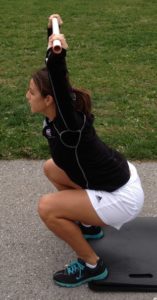
The overhead squat is, in my opinion, the best raw indicator of someone’s ability to move well. It requires full extension of the upper extremity and full flexion of the lower extremity at the same time. This requires a lot of mobility, stability and motor control.
Notice that I said “raw indicator.” I want to be clear about the fact that I would never use it solely for a screen or evaluation tool. There are way too many moving parts to be able to diagnose anything with this single movement. We also must evaluate movement in a single leg stance, lunge position, transverse plane and other areas. With all of that being said, if someone has a really good looking, unloaded overhead squat, odds are really good that they are going to move well in other areas.
Because it is such a complex movement and functional movement, many people look at the overhead squat as a training tool and prescribe progressions in the form of a load. I personally do like to use it in my training, but I only load it when their overhead squat looks good unloaded. Remember that load cements movement patterns, so if they have a bad looking squat and you load it, you just cemented that movement pattern.
How do you hack the overhead squat? The honest truth is…its complicated.
The overhead squat is one of the hardest movements to correct because the dysfunction can come from so many different areas and it is oftentimes multifactorial. I choose to correct all of the less complex movements that I can first and then go after the squat. Usually if I fix everything else, the squat improves on its own.
The hacks described here are all going to be dependent on a proper assessment being performed to decipher what is truly a mobility, stability, motor control or pattern issue. That is an entire blog post on it’s own, but I’ll save that for another day. The rest of this post is written under the assumption that you have done a phenomenal job of breaking down their movement pattern and understanding where their dysfunction lies.
Mobility Hacks
- Self Ankle Joint Mobilization: Poor ankle dorsiflexion might have the single biggest impact on the quality of a squat. If there is a dorsiflexion restriction, they will never be able to squat efficiently. This mobilization is performed with a band around the front of the ankle to lock it in. Push the knee forward over the 2nd and 3rd toes to the end of the range of motion and perform small oscillations from there.
- Tibial Internal Rotation Mobilization:
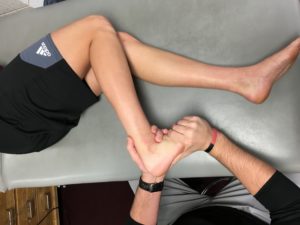 I have written extensively about the need for Tibial internal rotation in past blog posts because it does have a huge impact on the squat. Tibial internal rotation is best gained with a manual, hands on approach that I describe in detail in this blog post. You can also find more information in my ebook, “The 3 Mobility Issues that Haunt You.”
I have written extensively about the need for Tibial internal rotation in past blog posts because it does have a huge impact on the squat. Tibial internal rotation is best gained with a manual, hands on approach that I describe in detail in this blog post. You can also find more information in my ebook, “The 3 Mobility Issues that Haunt You.”
- Shinbox Stretch: Hip mobility is important to the squat, although I find that the majority of
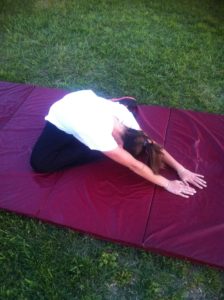 people that believe that they are restricted by poor hip mobility actually suffer from a lack of trunk stability. Many people are really struggling with their hip internal and external rotation and the shinbox stretch is a great way to improve it. Basically start in a shinbox position and reach out over one of your knees. Then, gradually walk your hands around until you are reaching over the opposite knee. This will challenge your range of motion with both internal and external rotation on each side.
people that believe that they are restricted by poor hip mobility actually suffer from a lack of trunk stability. Many people are really struggling with their hip internal and external rotation and the shinbox stretch is a great way to improve it. Basically start in a shinbox position and reach out over one of your knees. Then, gradually walk your hands around until you are reaching over the opposite knee. This will challenge your range of motion with both internal and external rotation on each side.
- Foam Roll Thoracic Spine Extension: A lot of people struggle with Thoracic spine
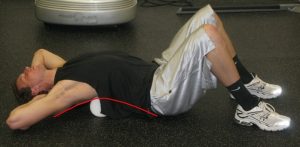 extension, which limits their ability to keep a bar or load over their head. An easy way to improve thoracic extension is by placing a foam roller at approximately T11-T12. Place your hands behind your head and try hard not to extend at the lumbar spine as you lay back over the top of the foam roll until a stretch is felt. Hold 3-5 seconds and repeat for multiple repetitions.
extension, which limits their ability to keep a bar or load over their head. An easy way to improve thoracic extension is by placing a foam roller at approximately T11-T12. Place your hands behind your head and try hard not to extend at the lumbar spine as you lay back over the top of the foam roll until a stretch is felt. Hold 3-5 seconds and repeat for multiple repetitions.
- Lat Stretch: The lats are another common area of mobility restriction that hinders
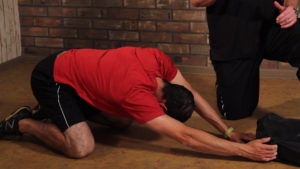 someone’s ability to keep a load over their head. I recommend doing some soft tissue work, such as IASTM or foam rolling over the lats first and then stretch them by grasping something with your hand (in this case an Ultimate Sandbag) and sit back into child’s pose until a stretch is felt.
someone’s ability to keep a load over their head. I recommend doing some soft tissue work, such as IASTM or foam rolling over the lats first and then stretch them by grasping something with your hand (in this case an Ultimate Sandbag) and sit back into child’s pose until a stretch is felt.
Stability Hacks:
- Diaphragm Taping: Taping the diaphragm has honestly become my favorite and most
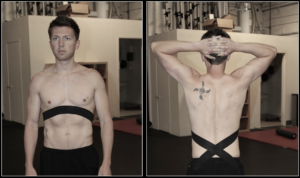 commonly used intervention for an overhead squat. What it tells me when it works is that even though a lot of things look like a mobility problem, they are usually caused by an underlying stability issue. Taping the diaphragm is my fastest, easiest, down and dirty way of improving trunk and core stability so I use this intervention a lot.
commonly used intervention for an overhead squat. What it tells me when it works is that even though a lot of things look like a mobility problem, they are usually caused by an underlying stability issue. Taping the diaphragm is my fastest, easiest, down and dirty way of improving trunk and core stability so I use this intervention a lot.
- Lying Reverse Squat: Most people don’t create enough stability naturally when they
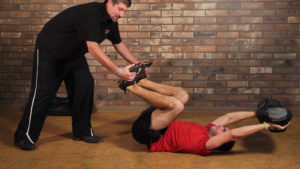 descend into the movement because they simply rely on gravity to get them to the bottom. Rather than being active and stable in their trunk, they simply just decide to try to control what gravity is doing for them naturally. When we introduce more stability and reverse patterning to the equation, they begin to “pull” themselves into the bottom of the squat and their technique improves quickly and efficiently. Have them lie on their back and grasp the tops of their feet with them in a slightly wider than shoulder width position, just as if they were going to perform a squat standing up. Have them actively pull their lower extremity into flexion against your manual resistance. I usually only perform this concentrically (by having them pull their legs to their chest). When they stand up and squat, coach them to pull themselves into the bottom, just as they did lying down, and their squat will look better.
descend into the movement because they simply rely on gravity to get them to the bottom. Rather than being active and stable in their trunk, they simply just decide to try to control what gravity is doing for them naturally. When we introduce more stability and reverse patterning to the equation, they begin to “pull” themselves into the bottom of the squat and their technique improves quickly and efficiently. Have them lie on their back and grasp the tops of their feet with them in a slightly wider than shoulder width position, just as if they were going to perform a squat standing up. Have them actively pull their lower extremity into flexion against your manual resistance. I usually only perform this concentrically (by having them pull their legs to their chest). When they stand up and squat, coach them to pull themselves into the bottom, just as they did lying down, and their squat will look better.
- Bruggers Lateral Walk: Many people fall into valgus collapse while squatting because of poor hip and foot control. The Bruggers lateral walk is extremely effective for loading the lateral line and improving trunk and core stability. The set up is a little bit tricky the first few times, but once you have it figured out. The lateral walks are simple. Perform them as you would any other band sidesteps.
Pattern Hacks: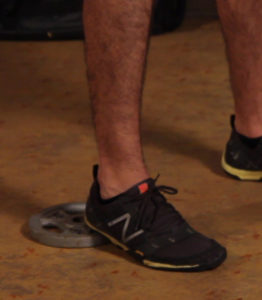
- Heel Lift: Some people have all of the necessary components and just don’t know how to put it all together. Sometimes doing something as simple as just modifying their center of gravity with a little bit different sensory input will wake up the nervous system and get it back on the right track. It always amazes me how big of a difference a simple heel lift can make. Just use caution with this…I do not recommend that you use this hack long term. If you do, you will change some timing and sequencing of the lower extremity for the worse and contribute to any ankle dorsiflexion issues that they may have. I prefer to start with the smallest heel lift that is necessary to see a good squat and then over a few weeks, I gradually decrease the thickness of the lift until they have a good looking squat without any lift.
- Bottom Up Squat: When you can’t get things to go the way you want them to, try doing them in reverse. We didn’t learn how to squat from the top down the first time in our lives so why would we think it is a good idea to improve a bad squat from the top down. Neurologically it just doesn’t make sense. Try having them sit on a box. I don’t care how they get there, just sit. Then fix their feet so they are symmetrical and in a good position. They can lead forward slightly with their upper body and then stand up. Their squat will always look better from the bottom up than the top down. Stay here and groove this
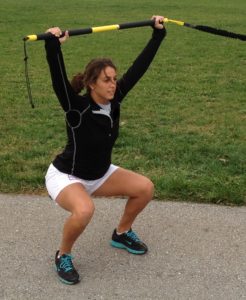 pattern for a while before you lock it in with load in a training session.
pattern for a while before you lock it in with load in a training session.
- Reactive Neuromuscular Training (RNT): This works great for people with a lateral deviation or rotation. You can put a band (or in this case a TRX Rip Trainer) at their hand, shoulder or hip level to make the needed corrections as they move through the squat. You want to feed the mistake and exaggerate it to make it the correction work.
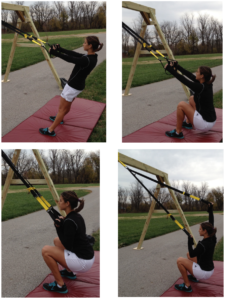 TRX Overhead Squat: This is a really effective squat correction because it helps improve mobility in a safe and comfortable environment. It combines the reverse patterning concept of working from the bottom up and also challenges stability by consciously loading the system. The simple version of this movement is that you need to grasp the handles of the suspension trainer (fully lengthened) and then drop into a deep squat. There, find a neutral spine position by moving your hips up or down until you eliminate the butt wink. Keeping tension on the straps, press them up overhead like you are sitting in the bottom of an overhead squat. Once the arms are fully extended, stand up into an upright position.
TRX Overhead Squat: This is a really effective squat correction because it helps improve mobility in a safe and comfortable environment. It combines the reverse patterning concept of working from the bottom up and also challenges stability by consciously loading the system. The simple version of this movement is that you need to grasp the handles of the suspension trainer (fully lengthened) and then drop into a deep squat. There, find a neutral spine position by moving your hips up or down until you eliminate the butt wink. Keeping tension on the straps, press them up overhead like you are sitting in the bottom of an overhead squat. Once the arms are fully extended, stand up into an upright position.
This is not an all encompassing list and there are a variety of other hacks that work well, but it is a pretty good list of some things to consider if you want to improve someone’s overhead squat.



Very interesting article, informative and well put together. Thank you, Mitch!